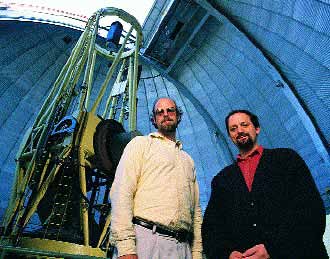AC8. Search for Habitable Planets

Chapter 8
We know of one habitable planet in the Universe, habitable meaning suitable for supporting life such as that we are familiar with. That one habitable planet is our own: Earth. For centuries, some people have speculated that there may be many many such planets in other planet-star systems. Until the latter part of the 20th century, there was no evidence that planets of any sort around other stars even existed, much less habitable planets like Earth. That’s not surprising. It’s nearly impossible to see exoplanets because they are very distant, very faint and lost in the overwhelming glare of the stars they orbit.

As of July 2007, only four exoplanets had been observed with direct imaging methods—planets that were very large and orbiting very faint stars with very large orbit radii. But although we cannot easily observe exoplanets directly, we have detected lots of them by certain effects they have on the stars they orbit. Here are the main methods that have been thought of:
The first detection of extrasolar planets was made by Alexander Wolszczan in 1994 by measuring the periodic change in arrival time of radio pulses from a pulsar—an incredibly dense neutron star, which is the remains of a supernova, that normally emits very regular pulses of radio waves.
Some exoplanet discoveries have been the result of looking for movement of the “parent” star. In Kepler’s Laws, the Sun is fixed at a point in space and the planet revolves around it. But why should the Sun be thus privileged? Kepler had rather mystical ideas about the Sun that justified its special place. However Newton, in connection with his 3rd Law, showed that the Sun does not occupy a privileged position. As a planet orbits its star, its gravity affects the star so that the two bodies actually orbit each other. Of course the larger body dominates and the smaller body moves a lot more. But the small movement of the star as the orbiting planet tugs on it can in theory be detected in two ways:
- If the star alternately moves towards us and away from us, its spectrum should shift slightly back and forth, alternately towards the blue end then towards the red end—a spectroscopic shift.
- We should be able to see the position of the star shift as well. Accurate measurement of position is known as astrometry.
Spectroscopes have been used to detect star spectrum shifts caused by orbiting giant planets. From ground-based observatories, spectroscopists can measure shifts due to velocity changes as small as 0.5 meters per second (1 mile per hour). This corresponds to a planet at least 33 times the mass of Earth orbiting a Sun-like star. No exoplanet detections have been confirmed using astrometry, but there have been many exoplanet discoveries with the spectroscopic method.
The other practical way to discover exoplanets is to watch the periodic dimming of the star caused by a planet passing in front of the star—an event known as a transit.
Measuring brightness is known as photometry. This method in theory, with four years of observing, could detect planets about half the mass of Earth in a 1 AU radius orbit about a sun-like star or a Mars mass planet in a Mercury-like orbits. Planets with orbital periods greater than two years are not readily detectable, since their chance of being properly aligned along the line of sight to the star is very small. Photometry is the only practical method for finding Earth-size planets in the habitable zone.
One of the most prolific exoplanet finding projects was the NASA Kepler Mission. To find out about that mission, see the GSS NASA Kepler Mission page.
For an up-to-date accounting of all exoplanet discoveries, see
The Extrasolar Planets Encyclopaedia at http://exoplanet.eu/ or
The NASA Exoplanet Archive at https://exoplanetarchive.ipac.caltech.edu

AC8.1. Investigation:
Exoplanet Transits
Plot and analyze a light curve for a planet transit. Then, from transit data, find out critical properties of a planet that could make the planet habitable or not.
~~~

Eos/AGU articles
See relatively recent Eos/AGU articles on exoplanets – https://eos.org/tag/exoplanets
Investigation from European Hands-On Universe project: Discover an exoplanet: the transit method.
Just for fun, watch this video by A Capella Science, Trudbol, SamRobson, Gia Mora, (https://www.youtube.com/watch?v=gai8dMA19Sw). 8.5 min long; March 2017:

